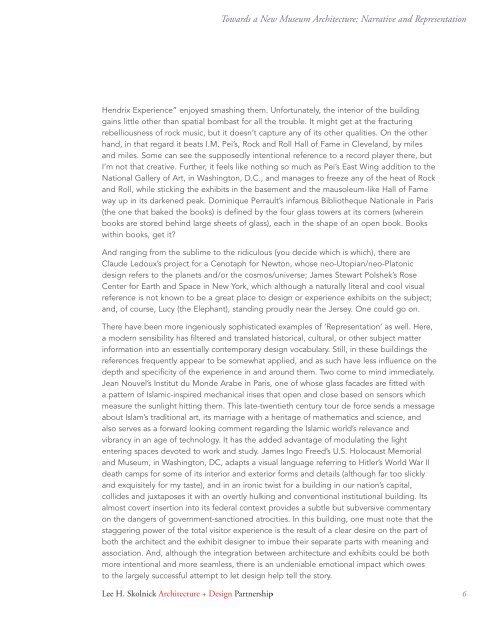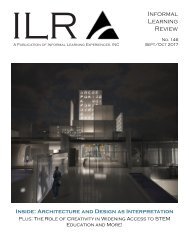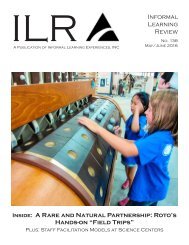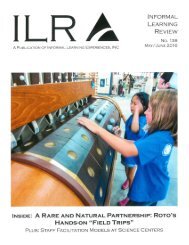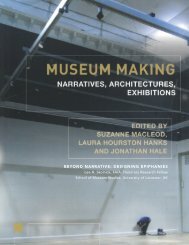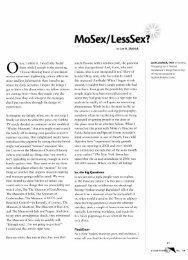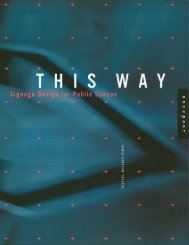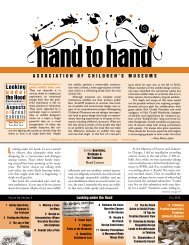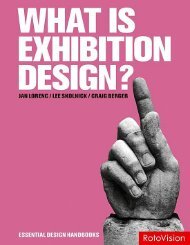Reshaping Mus-Leicester
- No tags were found...
Create successful ePaper yourself
Turn your PDF publications into a flip-book with our unique Google optimized e-Paper software.
Towards a New <strong>Mus</strong>eum Architecture: Narrative and Representation<br />
Hendrix Experience” enjoyed smashing them. Unfortunately, the interior of the building<br />
gains little other than spatial bombast for all the trouble. It might get at the fracturing<br />
rebelliousness of rock music, but it doesn’t capture any of its other qualities. On the other<br />
hand, in that regard it beats I.M. Pei’s, Rock and Roll Hall of Fame in Cleveland, by miles<br />
and miles. Some can see the supposedly intentional reference to a record player there, but<br />
I’m not that creative. Further, it feels like nothing so much as Pei’s East Wing addition to the<br />
National Gallery of Art, in Washington, D.C., and manages to freeze any of the heat of Rock<br />
and Roll, while sticking the exhibits in the basement and the mausoleum-like Hall of Fame<br />
way up in its darkened peak. Dominique Perrault’s infamous Bibliotheque Nationale in Paris<br />
(the one that baked the books) is defined by the four glass towers at its corners (wherein<br />
books are stored behind large sheets of glass), each in the shape of an open book. Books<br />
within books, get it?<br />
And ranging from the sublime to the ridiculous (you decide which is which), there are<br />
Claude Ledoux’s project for a Cenotaph for Newton, whose neo-Utopian/neo-Platonic<br />
design refers to the planets and/or the cosmos/universe; James Stewart Polshek’s Rose<br />
Center for Earth and Space in New York, which although a naturally literal and cool visual<br />
reference is not known to be a great place to design or experience exhibits on the subject;<br />
and, of course, Lucy (the Elephant), standing proudly near the Jersey. One could go on.<br />
There have been more ingeniously sophisticated examples of ‘Representation’ as well. Here,<br />
a modern sensibility has filtered and translated historical, cultural, or other subject matter<br />
information into an essentially contemporary design vocabulary. Still, in these buildings the<br />
references frequently appear to be somewhat applied, and as such have less influence on the<br />
depth and specificity of the experience in and around them. Two come to mind immediately.<br />
Jean Nouvel’s Institut du Monde Arabe in Paris, one of whose glass facades are fitted with<br />
a pattern of Islamic-inspired mechanical irises that open and close based on sensors which<br />
measure the sunlight hitting them. This late-twentieth century tour de force sends a message<br />
about Islam’s traditional art, its marriage with a heritage of mathematics and science, and<br />
also serves as a forward looking comment regarding the Islamic world’s relevance and<br />
vibrancy in an age of technology. It has the added advantage of modulating the light<br />
entering spaces devoted to work and study. James Ingo Freed’s U.S. Holocaust Memorial<br />
and <strong>Mus</strong>eum, in Washington, DC, adapts a visual language referring to Hitler’s World War II<br />
death camps for some of its interior and exterior forms and details (although far too slickly<br />
and exquisitely for my taste), and in an ironic twist for a building in our nation’s capital,<br />
collides and juxtaposes it with an overtly hulking and conventional institutional building. Its<br />
almost covert insertion into its federal context provides a subtle but subversive commentary<br />
on the dangers of government-sanctioned atrocities. In this building, one must note that the<br />
staggering power of the total visitor experience is the result of a clear desire on the part of<br />
both the architect and the exhibit designer to imbue their separate parts with meaning and<br />
association. And, although the integration between architecture and exhibits could be both<br />
more intentional and more seamless, there is an undeniable emotional impact which owes<br />
to the largely successful attempt to let design help tell the story.<br />
6


